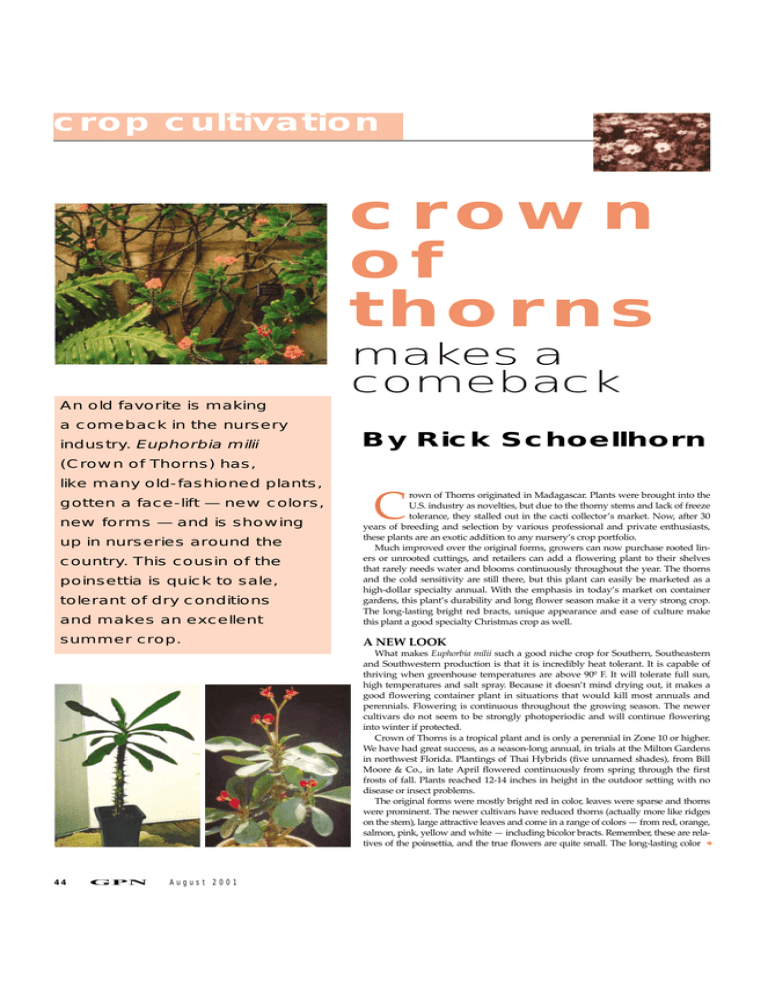crown of thorns makes a
advertisement

crop cultivation crown of thorns makes a comeback An old favorite is making a comeback in the nursery industry. Euphorbia milii By Rick Schoellhorn (Crown of Thorns) has, like many old-fashioned plants, C and makes an excellent rown of Thorns originated in Madagascar. Plants were brought into the U.S. industry as novelties, but due to the thorny stems and lack of freeze tolerance, they stalled out in the cacti collector’s market. Now, after 30 years of breeding and selection by various professional and private enthusiasts, these plants are an exotic addition to any nursery’s crop portfolio. Much improved over the original forms, growers can now purchase rooted liners or unrooted cuttings, and retailers can add a flowering plant to their shelves that rarely needs water and blooms continuously throughout the year. The thorns and the cold sensitivity are still there, but this plant can easily be marketed as a high-dollar specialty annual. With the emphasis in today’s market on container gardens, this plant’s durability and long flower season make it a very strong crop. The long-lasting bright red bracts, unique appearance and ease of culture make this plant a good specialty Christmas crop as well. summer crop. A NEW LOOK gotten a face-lift — new colors, new forms — and is showing up in nurseries around the country. This cousin of the poinsettia is quick to sale, tolerant of dry conditions What makes Euphorbia milii such a good niche crop for Southern, Southeastern and Southwestern production is that it is incredibly heat tolerant. It is capable of thriving when greenhouse temperatures are above 90º F. It will tolerate full sun, high temperatures and salt spray. Because it doesn’t mind drying out, it makes a good flowering container plant in situations that would kill most annuals and perennials. Flowering is continuous throughout the growing season. The newer cultivars do not seem to be strongly photoperiodic and will continue flowering into winter if protected. Crown of Thorns is a tropical plant and is only a perennial in Zone 10 or higher. We have had great success, as a season-long annual, in trials at the Milton Gardens in northwest Florida. Plantings of Thai Hybrids (five unnamed shades), from Bill Moore & Co., in late April flowered continuously from spring through the first frosts of fall. Plants reached 12-14 inches in height in the outdoor setting with no disease or insect problems. The original forms were mostly bright red in color, leaves were sparse and thorns were prominent. The newer cultivars have reduced thorns (actually more like ridges on the stem), large attractive leaves and come in a range of colors — from red, orange, salmon, pink, yellow and white — including bicolor bracts. Remember, these are relatives of the poinsettia, and the true flowers are quite small. The long-lasting color ➧ 44 GPN August 2001 crop cultivation comes from small bracts surrounding small, yellowish true flowers. There are still compact, small-leaved varieties available on the market (check out ‘Short & Sweet’ from Oglesby), and intermediate forms that have flowers 1/2-inch in diameter. Newer releases from Thailand include some extremely large forms, which will reach three feet in height and have leaves up to 12 inches in length. succulents, you can market these as plants for dry, windy or coastal locations. Whichever variety you select to try, production guidelines are very similar. Media. Media must be extremely well-drained; plants prefer to dry down between waterings. A little sand in the potting mix will help stabilize production containers. These plants have thick stems and a topPRODUCTION heavy growth habit that may cause GUIDELINES pots to tip over in lightweight mixes. Crown of Thorns is a slowWater/Fertility. Dry these plants growing plant, so cuttings are out! If planting unrooted or rooted usually shipped either bare root, cuttings, keep media only slightly or callused. Many firms are shipmoist until new growth begins to ping rooted cuttings with dry emerge. Once the plants are growing, roots; this is not usually a problem they can handle normal moisture as new roots form quickly. levels but will flower better if kept Rooting takes from 14-21 days; slightly drier. Excessive drying out bottom heat is best but not essencan cause lower leaf drop on largetial during rooting. Once cuttings leafed cultivars. are rooted, most cultivars begin Euphorbia milii prefers moderate ferflowering immediately, so for tility levels in production. One of the quick turnover, try three cuttings few ways to keep this plant from flowof smaller cultivars in a 4- to 5ering is to overfertilize. Either a soluinch pot, one cutting per pot on tion containing 150-275 ppm fertilizer the larger cultivars. Deeper plant or a medium rate of slow-release fertilliners will help keep stems izer are adequate at planting. Try upright until the root system gets using a high-phosphorus fertilizer established. Crop time varies with when plants have reached salable size. the type of cutting or liner you While red is the “old standby,” Crown of Thorns now comes in a variety of colors, including The leaf color of many cultivars is natbegin with: in 4-inch pots, it takes cream, pink and bi-colors. urally a pale green; don’t let that roughly 12-14 weeks (similar to encourage overfertilizing of plants. kalanchoe); larger pots, such as 1-gallon, take from 16-20 weeks; and a Light. Plants need full sun to form flowers; avoid low-light produc3-gallon crop may take as much as 30-35 weeks. Many Northern growtion areas. For most of the country these plants will tolerate full, direct ers may want to look into prefinished plants. For retailers, this is an sun in production and in the landscape. Growers at high elevations may excellent plant for customers who forget to water; mixed with other need light shade for best growth. ➧ 1/2 Horizontal BECKER UNDERWOOD Ad # 46 GPN August 2001 1/6 Vertical MESSERSMITH Ad # 1/3 Page Square Temperature. In production grow plants warm (65° F or higher); they will slow down or go dormant in cold greenhouses, or when planted in cold, wet media. If plants are well-rooted in containers, cool temperatures will frequently induce leaf drop and reduced flowering. Plants go dormant under cold conditions, but as long as they remain dry will survive for months in a dormant state. DISEASES AND PESTS MCHUTCHISON Ad # Clean stock is essential, but problems are relatively few. Like all euphorbias, Crown of Thorns is most sensitive to fungal problems during propagation phases of production. A preventative drench with a broad-spectrum fungicide immediately after planting will protect the crop during rooting. There are no specific insect problems, but Euphorbia milii can host mealy bug, scale or whitefly. Viral problems have been seen when poor-quality stock is used. GPN Rick Schoellhorn is a floriculture extension specialist at the University of Florida, Gainesville, Fla. He can be reached via phone at (352) 392-5670 or e-mail at rksch@mail.ifas.ufl.edu. Culture at a Glance Common name: Crown of Thorns, Christ’s Thorn Family: Euphorbiaceae, Milkweed/Spurge Height x width: 1-3 feet x 2-3 feet (3 feet x 18 inches for species) Growth rate: slow Foliage: semi-prostrate to rambling habit; slender, fleshy, thorny, 5-6-sided stems; bright green, tough, obovate, 1-inchlong leaves Flowers: yellow cyathia enclosed by red bracts is most common; other colors include yellow, gold and orange Light: full to bright sun Temperature: warm to cool Watering: low, allow to dry between waterings Fertility: moderate Humidity: low Soil: well-drained 1/2 Page Island Pests and problems: root rots, stem rots, aphids and mealybugs Growth regulators: no growth regulators required HARNOIS INDUSTRIES Ad # Uses: desert garden, flowering Propagation: tip cuttings Cultivars available: small cultivars: Short & Sweet, Palace Athene, Selene, Egina, Marathon and Hera; midsize: Rosemarie, Gabi, Karola, Bianca, Olympus, Saturnus, Vemidas, Rosalie, Vulcanus and Themis; larger types: Rainbow, Apple Blossom, Blushing Bride, Tuti-fruity, Coral, Primrose Yellow and Thai Hybrids Other interest: from the Latin euphorbea for Euphorbius, a Greek physician in 1 AD who used the sap medicinally; native to Madagascar; milky latex sap “bleeds” when stems are cut, and can be stopped by immersing in warm water; sap may cause skin irritation or blindness; from a very large genus of over 2,000 species including the popular poinsettia; supposedly the plant used for Christ’s crown of thorns


